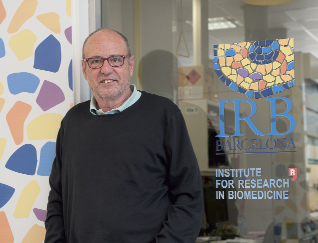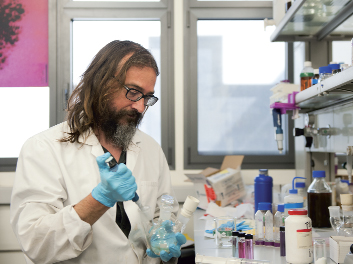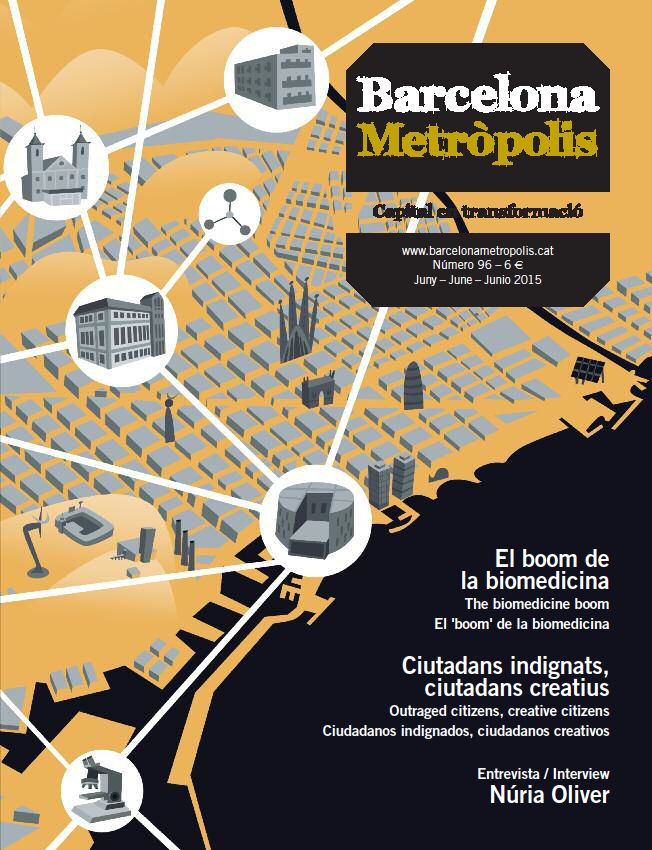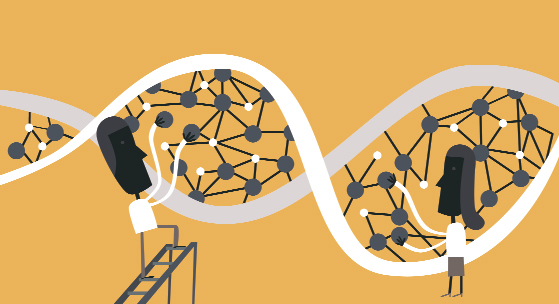It is unusual for centres where the workforce is mainly made up of doctors and biologists to have a chemistry department. Yet this very department is one of the elements underpinning Barcelona’s Institute for Research in Biomedicine.
On one of the lab tables there are some small spheres connected by rods. This is the traditional way of building models to study the structure and characteristics of molecules, although most researchers now work with three-dimensional models projected on their computer screens. They inspect them, spin them around, and wonder what would happen if just this part were tweaked… And of course, the classic stereotypical image of chemists can also be seen: people in lab coats mixing substances. The isolated central area is used to perform one of the basic tasks; this is where they synthesise small peptides, i.e. proteins made up of short chains of amino acids.
This is one of the chemistry labs at the Institute for Research in Biomedicine (IRB Barcelona). The IRB was founded in 2005 by the Catalan Government and the University of Barcelona and is located in the Barcelona Science Park. It is unusual for centres where the workforce is mainly made up of doctors and biologists to have a chemistry department. However, chemistry is one of the elements underpinning the IRB, together with structural and cellular biology, molecular medicine and oncology.
According to Xavier Salvatella, a chemist by training and researcher for the Catalan Institution for Research and Advanced Studies who leads a research group in molecular biophysics, “this is one of the features that sets the IRB apart from other centres. It has two advantages. Firstly, it is practical, because often the research we do involves using molecules that could be made into drugs, and having experts who can synthesise them. The second is conceptual: chemists tend to have a mindset that is more mechanical, and when this is put together with the thinking of doctors and biologists, there is potential for some very original projects. It forces us to look for the chemical reactions or structural changes that are behind what we observe on a biological level”.
And it is a deeper understanding of biological phenomena that has given chemistry greater importance. As biomedical sciences find the molecular causes for diseases, chemistry can play a more central part in research, looking for molecules that may act in a certain way or intervene in a specific process. Understanding why metastasis occurs in cancer or which proteins are involved in a certain process opens the door to finding the proper intervention.

© Albert Armengol
Ernest Giralt, Coordinator of the Molecular Chemistry and Pharmacology program at IRB Barcelona.
According to Ernest Giralt, coordinator of the Molecular Chemistry and Pharmacology program at the IRB and professor at the University of Barcelona, it makes three main contributions. “Firstly, we create molecules that are designed to interact with others through weak bonds, i.e. without fully forming a new compound with a stronger type of bond. The net result of these weak interactions is enough to provide activity that can alter some processes. Furthermore, they have to be very selective and only act in the places and in the manner we want them to”, he affirms. The department’s second essential contribution concerns protein structures. “Until recently, the biological function of a protein was associated with a specific structure, but we now know that some proteins act without a well-defined structure. This means we can make them work towards various objectives. And computational chemistry – the use of computer simulation – helps determine their mechanism.”
Finally, Giralt points out that chemists can now design and synthesise any molecule, however complex it may be, in order to test it for a possible pharmaceutical use or simply because the molecule is needed to perform an experiment. It would appear that the only limit to the proposals his department comes up with is the imagination of its chemists. In any case, if a proposal were too bold the opinions of the biologists and doctors -and the experiments themselves- would rein it in.
In the nanoworld
While molecules of various dimensions can be found at the IRB Barcelona, at the Catalan Institute of Nanoscience and Nanotechnology (ICN2) the focus is on an even smaller world . Located on the Autonomous University of Barcelona campus, the ICN2 works with nanostructures and nanoparticles, which by definition are entities measuring between one and one hundred nanometres (between one and one hundred billionths of a metre), hence the name.
These reduced dimensions enable very specific and precise operations. Given that nanotechnology is proving to have a key role in numerous fields, from power generation to the production of materials with remarkable new properties, it is no surprise that it is contributing to biomedicine as well. According to Víctor Puntes, head of the Inorganic Nanoparticles research group, “the relationship between biomedicine and nanotechnology sees the latter serving the former. There are treatments based on nanoparticles, and nanoparticles are used to apply radiation therapy or to obtain higher resolution images with a smaller dose of radiation. However, what nanotechnology enables above all is highly advanced detection, protection, transportation and release of drugs”. This means that the nanoparticles can transport a drug to the desired location without it being attacked and destroyed, and once there, release it to perform its task. This ensures the drug’s action, avoids side effects and reduces the doses needed.

© Albert Armengol
Víctor Puntes, Head of the inorganic nanoparticles group at the Catalan Institute of Nanoscience and Nanotechnology.
Puntes gives the example of a research project that began in 2005 when a clinical oncologist from the Sant Pau Hospital came to talk to him about cisplatin. This is an anti-tumour drug which is widely used and effective, but also very damaging to the kidneys. Puntes’s group had the idea of attaching nanoparticles of gold to the cisplatin, the composite being too large to penetrate the kidneys. The healing effect was still there, while the damage to the kidneys was prevented. This also meant that larger doses could be given. In 2008 they patented the particle and licensed the rights. They set up a spin-off , Nanotargeting, to get its industrial production under way, working with the Swiss firm Nanonica. Now they are conducting the regulatory preclinical testing to obtain authorisation for its use.
This example tells us two things. One, highlighted by Puntes, is that “nanotechnology and biomedicine have a future together and it is clear that Barcelona and its research area are important players on the international scene”. Hence while keeping the ICN2 lab going, they are opening another at the Vall d’Hebron Research Institute (VHIR) to expedite the possibilities nanotechnology provides to medical practice.
At the same time, it also shows how research creates opportunities for setting up companies that are small yet highly technological and deliver enormous added value. This means that the laboratory’s work has borne immediate fruit that improves people’s health, and also that companies have emerged from investment in research and excellence which create highly skilled jobs and contribute to the strength and diversity of Catalonia’s industrial sector. Essentially, the elevated levels of chemistry and biology are enhancing one another and the reaction between the two is synthesising new steps forward.




